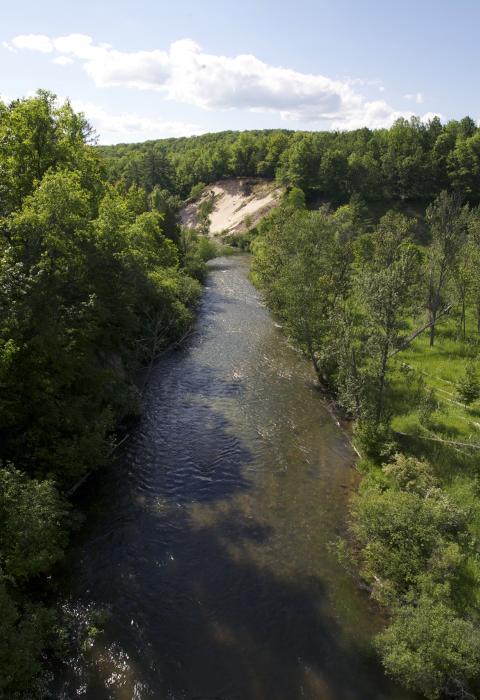Pine River
Michigan
The Pine River is located in the Lower Peninsula of Michigan near the town of Cadillac and offers small-craft boating, high-quality fishing, and outstanding scenery. Although the river is best known for boating (primarily canoeing) and trout fishing, several other recreational activities are popular, including picnicking, hunting, wildlife viewing, and swimming. Trout fishing is a popular activity during the early morning and evening throughout the summer. The majority of anglers fish from shore, but access by boat is also common. Numerous user-developed foot trails to popular fishing areas are located along the shoreline.
The U.S. Forest Service has established a watercraft permit system that restricts watercraft use to 616 watercraft/day on weekdays and 240 watercraft on weekends from May 15 through September 10th. Watercraft permits are available at local U.S. Forest Service offices and private liveries.
Camping within the river corridor on National Forest System lands is allowed only at designated sites, and there are fees for camping and using access sites. U.S. Forest Service access sites are plowed in the winter, providing year-round access.
Designated Reach
March 3, 1992. The segment from Lincoln Bridge to the east 1/16th line of Section 16, T21N, R13W.
Outstandingly Remarkable Values
Recreation
Visitors to the Pine River Corridor continue to enjoy a variety of recreation experiences in natural appearing settings. Visitors may encounter both non-motorized and motorized recreation on land within the Pine River corridor (such as hiking, mountain biking, hunting, and auto touring), while only non-motorized recreation is encountered in the river channel. High-quality commercial services are available for recreation activities, particularly for boating and fishing.
Watercraft use, particularly canoeing, is an important recreation activity on the Pine River. The river character provides watercraft users with a moderate challenge in practicing boating and water safety skills and a high degree of interaction with the natural environment. Watercraft traffic on the river and motorized vehicle traffic at the landings on weekends and holidays are maintained at a level where the visitors’ experiences are not significantly diminished. Boating use declines considerably on weekdays, providing quality opportunities to view wildlife and experience solitude.
Fishing on the Pine River is another popular recreation activity. The Pine River is considered a “blue ribbon” trout fishery and many anglers take advantage of the early morning and evening hours and weekdays to fish with some degree of solitude.
Limited overnight camping is allowed at designated sites outside of developed campgrounds, providing an opportunity for a rustic riverside camping experience. Other recreation activities, such as hunting and trapping, developed area camping, picnicking, hiking, watching wildlife, and socializing, are commonly enjoyed by visitors to the Pine River. Recreation use from late fall to late spring is low, providing opportunities for people to enjoy the river corridor with few other encounters.
Recreation facility developments are limited to those necessary for protecting the river resources while providing some comfort and convenience for visitors at access points and rest stops. A rest stop for watercraft users is located along the river between Peterson Bridge and Low Bridge, helping to reduce trespass on private lands and the problem of human waste along the shorelines in undeveloped areas.
Scenery
The Pine River corridor is well known for its outstanding riverine scenery. Travelers along the corridor enjoy views of a narrow, winding river with a variety of colors, forms, and textures from the diverse vegetation, steep banks, and unique clay formations. The primary forest type is a mixture of conifers and hardwoods, with full crowns, bark color, and patterns that resemble old growth. Viewers continue to see natural erosion processes as the dynamic mechanics of the Pine River progress. Opportunities to view wildlife have increased as habitat conditions are enhanced. The relatively few, scattered recreational and residential developments blend in with the natural scenery and are mostly screened from the view of recreationists on the river. Management activities, including signing, are subordinate to the character of the natural landscape.

